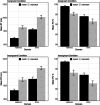Mental association of time and valence
- PMID: 37845405
- PMCID: PMC10896927
- DOI: 10.3758/s13421-023-01473-9
Mental association of time and valence
Abstract
Five experiments investigated the association between time and valence. In the first experiment, participants classified temporal expressions (e.g., past, future) and positively or negatively connotated words (e.g., glorious, nasty) based on temporal reference or valence. They responded slower and made more errors in the mismatched condition (positive/past mapped to one hand, negative/future to the other) compared with the matched condition (positive/future to one hand, negative/past to the other hand). Experiment 2 confirmed the generalization of the match effect to nonspatial responses, while Experiment 3 found no reversal of this effect for left-handers. Overall, the results of the three experiments indicate a robust match effect, associating the past with negative valence and the future with positive valence. Experiment 4 involved rating the valence of time-related words, showing higher ratings for future-related words. Additionally, Experiment 5 employed latent semantic analysis and revealed that linguistic experiences are unlikely to be the source of this time-valence association. An interactive activation model offers a quantitative explanation of the match effect, potentially arising from a favorable perception of the future over the past.
Keywords: Concepts; Time perception; Valence.
© 2023. The Author(s).
Conflict of interest statement
We have no conflicts of interest to declare.
Figures







References
-
- Baroni M, Bernardini S, Ferraresi A, Zanchetta E. The WaCky wide web: A collection of very large linguistically processed web-crawled corpora. Language Resources and Evaluation. 2009;43:209–226. doi: 10.1007/s10579-009-9081-4. - DOI
-
- Bates D, Mächler M, Bolker B, Walker S. Fitting linear mixed-effects models using lme4. Journal of Statistical Software. 2015;67:1–48. doi: 10.18637/jss.v067.i01. - DOI
Publication types
MeSH terms
Grants and funding
LinkOut - more resources
Full Text Sources
Miscellaneous

